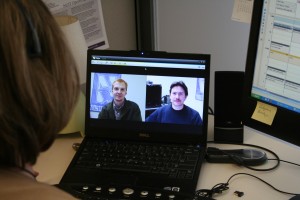On April 6, 2010, NUIT announced, to the entire Northwestern Community, that a cross platform videoconferencing service, which delivers high quality audio, video and data sharing to individual desktops, is available for use.

To my knowledge, this is a first for a university to extend videoconferencing capabilities beyond the fixed room-based conference rooms or classrooms, which is now front and center for each individual on campus. One of the many strengths of this technology is the ability to connect with the existing room-based H.323 infrastructure we have across campus, which numbers around 60 rooms of integrated videoconferencing systems as well as a 40 port video bridge, gatekeeper and gateway.
This new service, which has been in use by select research and academic programs since January 2010, is delivering a long felt need to improve efficiency, reduce time and costs traveling, and by the use of technology, it will be a critical component in supporting the goals of One Northwestern. With an estimated 25,000 researchers, faculty, staff and students, we’ll be expanding our infrastructure with the needs of the campus.
User accounts, which are accessible from the NU Desktop Videoconferencing website via the request form, require a web camera, microphone and speaker to utilize the service. The current version of software, powered by Vidyo and it’s scalable video coding (SVC), is able to perform in a variety of conditions which are not conducive to traditional videoconferencing systems. So, flexibility, in terms of performance and location, are keys to the success of this service.
This technology has already been written into several grants, most recently being a NSF funded project which will bring desktop videoconferencing into the laboratories of the Oncofertility Consortium here at Northwestern University. The goal is to deliver interactive discussions with researchers at different locations on the live data from electron microscopes and the scientists controlling the experiment. A preview of this can be viewed on a previous post, Microscopes and Vidyo.
